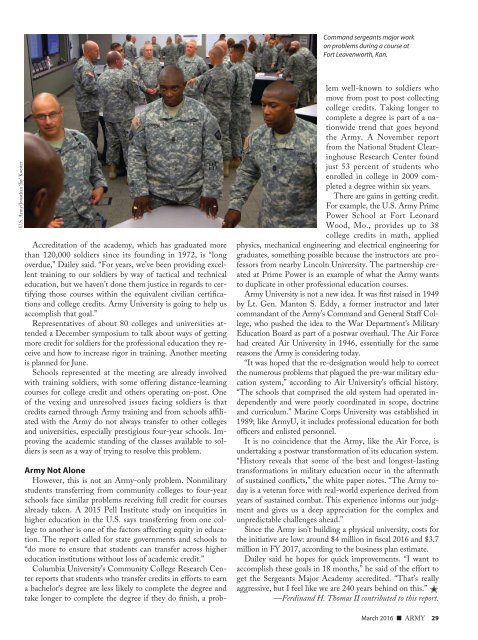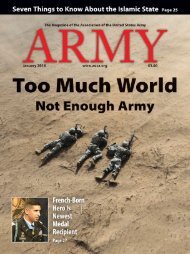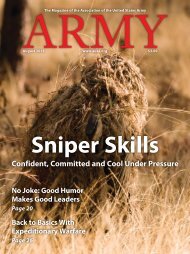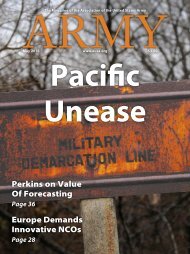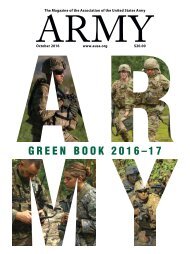Army - Stimulating Simulation
Create successful ePaper yourself
Turn your PDF publications into a flip-book with our unique Google optimized e-Paper software.
Command sergeants major work<br />
on problems during a course at<br />
Fort Leavenworth, Kan.<br />
U.S. <strong>Army</strong>/Jonathan ‘Jay’ Koester<br />
Accreditation of the academy, which has graduated more<br />
than 120,000 soldiers since its founding in 1972, is “long<br />
overdue,” Dailey said. “For years, we’ve been providing excellent<br />
training to our soldiers by way of tactical and technical<br />
education, but we haven’t done them justice in regards to certifying<br />
those courses within the equivalent civilian certifications<br />
and college credits. <strong>Army</strong> University is going to help us<br />
accomplish that goal.”<br />
Representatives of about 80 colleges and universities attended<br />
a December symposium to talk about ways of getting<br />
more credit for soldiers for the professional education they receive<br />
and how to increase rigor in training. Another meeting<br />
is planned for June.<br />
Schools represented at the meeting are already involved<br />
with training soldiers, with some offering distance-learning<br />
courses for college credit and others operating on-post. One<br />
of the vexing and unresolved issues facing soldiers is that<br />
credits earned through <strong>Army</strong> training and from schools affiliated<br />
with the <strong>Army</strong> do not always transfer to other colleges<br />
and universities, especially prestigious four-year schools. Improving<br />
the academic standing of the classes available to soldiers<br />
is seen as a way of trying to resolve this problem.<br />
<strong>Army</strong> Not Alone<br />
However, this is not an <strong>Army</strong>-only problem. Nonmilitary<br />
students transferring from community colleges to four-year<br />
schools face similar problems receiving full credit for courses<br />
already taken. A 2015 Pell Institute study on inequities in<br />
higher education in the U.S. says transferring from one college<br />
to another is one of the factors affecting equity in education.<br />
The report called for state governments and schools to<br />
“do more to ensure that students can transfer across higher<br />
education institutions without loss of academic credit.”<br />
Columbia University’s Community College Research Center<br />
reports that students who transfer credits in efforts to earn<br />
a bachelor’s degree are less likely to complete the degree and<br />
take longer to complete the degree if they do finish, a problem<br />
well-known to soldiers who<br />
move from post to post collecting<br />
college credits. Taking longer to<br />
complete a degree is part of a nationwide<br />
trend that goes beyond<br />
the <strong>Army</strong>. A November report<br />
from the National Student Clearinghouse<br />
Research Center found<br />
just 53 percent of students who<br />
enrolled in college in 2009 completed<br />
a degree within six years.<br />
There are gains in getting credit.<br />
For example, the U.S. <strong>Army</strong> Prime<br />
Power School at Fort Leonard<br />
Wood, Mo., provides up to 38<br />
college credits in math, applied<br />
physics, mechanical engineering and electrical engineering for<br />
graduates, something possible because the instructors are professors<br />
from nearby Lincoln University. The partnership created<br />
at Prime Power is an example of what the <strong>Army</strong> wants<br />
to duplicate in other professional education courses.<br />
<strong>Army</strong> University is not a new idea. It was first raised in 1949<br />
by Lt. Gen. Manton S. Eddy, a former instructor and later<br />
commandant of the <strong>Army</strong>’s Command and General Staff College,<br />
who pushed the idea to the War Department’s Military<br />
Education Board as part of a postwar overhaul. The Air Force<br />
had created Air University in 1946, essentially for the same<br />
reasons the <strong>Army</strong> is considering today.<br />
“It was hoped that the re-designation would help to correct<br />
the numerous problems that plagued the pre-war military education<br />
system,” according to Air University’s official history.<br />
“The schools that comprised the old system had operated independently<br />
and were poorly coordinated in scope, doctrine<br />
and curriculum.” Marine Corps University was established in<br />
1989; like <strong>Army</strong>U, it includes professional education for both<br />
officers and enlisted personnel.<br />
It is no coincidence that the <strong>Army</strong>, like the Air Force, is<br />
undertaking a postwar transformation of its education system.<br />
“History reveals that some of the best and longest-lasting<br />
transformations in military education occur in the aftermath<br />
of sustained conflicts,” the white paper notes. “The <strong>Army</strong> today<br />
is a veteran force with real-world experience derived from<br />
years of sustained combat. This experience informs our judgment<br />
and gives us a deep appreciation for the complex and<br />
unpredictable challenges ahead.”<br />
Since the <strong>Army</strong> isn’t building a physical university, costs for<br />
the initiative are low: around $4 million in fiscal 2016 and $3.7<br />
million in FY 2017, according to the business plan estimate.<br />
Dailey said he hopes for quick improvements. “I want to<br />
accomplish these goals in 18 months,” he said of the effort to<br />
get the Sergeants Major Academy accredited. “That’s really<br />
aggressive, but I feel like we are 240 years behind on this.” ✭<br />
—Ferdinand H. Thomas II contributed to this report.<br />
March 2016 ■ ARMY 29


